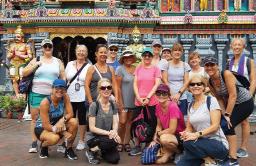
4 minute read
Singapore Blooms
ORCHIDS AND OTHER PLANTS THAT THRIVE HERE
Written by and photoGRAPHY by Helena Antolin Cochrane
Advertisement
Like many of you, I struggle with envy, which I try to mask as admiration, when I spy a beautifully thriving selection of house plants in someone else’s home. The beautiful, air-purifying, calm-inducing greens and blooms do wonders for a home’s atmosphere, especially now that we’ve all spent so much time at Moisture and light in balance, whether our plants are exposed to direct sun or not, and the growing medium (dirt) we put the plants in all determine their health and longevity. From easiest to most challenging, here are some species that can add color and oxygen to your home.
home. This begs the question: How can I make my urban balcony an attractive green space featuring lush blooms? If Singapore is a garden in a city, it ought to be a snap for me, too, to “Make Singapore
Zamioculcas zamiifolia or ZZ plant
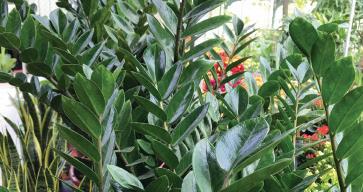
Our Garden.” The experts at the NParks Horticulture Centre advise home hobbyists to take the route of the tried and true. In Singapore, that can mean allowing for conditions in an air-conditioned office or flat, though many of us are hoping to beautify a condo balcony.
Monstera Alfonsii or Swiss-cheese plant
Zamioculcas zamiifolia, better known as the “ZZ plant,” was introduced to Singapore around the year 2000. It has grown in popularity for its beautiful, glossy, succulent, green leaves, and is auspiciously nicknamed the “gold coin plant,” in a nod to the Chinese New Year’s penchant for prosperity. ZZ plants’ leaves retain moisture, so they do not demand frequent watering. Monstera Alfonsii, or “Swiss-cheese plant,” is in the family of epiphytes: plants that thrive in environments where they can climb, as well as having their roots exposed to air, since they gather moisture from the environment through their leaves. Swiss-cheese plant leaves have striking holes that add to their tropical beauty, and they require neither full sun nor heavy watering. Sansevieria, a.k.a. “snake plant” or “mother-in-law’s tongue,” is highly popular in apartments and office buildings, on balconies, and even in the ground, for its ease and adaptability. Studies performed by NASA have shown that the snake plant removes formaldehyde and benzene from the air. This makes it a particularly healthy plant to keep in your home
or office, where you may not ever have the windows open. Others that are known for their adaptability to a wide variety of conditions and can withstand the neglect that could spring from our busy work or travel schedules are tillandsia (air plants) and chlorophytum comosum (spider plants), which literally hang around, producing offshoots even in the quietest, most indirectly-lit corner. Finally, let’s turn our attention to the national flower of Singapore: the orchid. All the experts I’ve consulted caution that while an orchid may be the most attractive plant for my balcony, it is not the Any species of orchid must have plenty of air circulating around the roots, lest they get “wet feet” leading to crown or root rot, the final blow before expiration. Many orchids that appear deceased are not dead, however. They are dormant and will regenerate with patient care. After trimming the dry stems and stalks, minimal watering and plenty of circulating air in the root area should give you some hopeful shoots that bloom again in several months. When it comes to orchids, enjoy the process, and be patient with the product. Remember that even here, a growing cycle will test your resolve to obtain a
Sansevieria, or snake plant
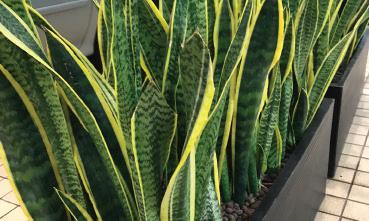
one that an impatient gardener will be able to foster successfully. There are two main species of orchid. Phalaenopsis, or “moth orchids,” are grown with curved stems to allow the moth-shaped blooms to descend downward from an arch. They typically are sold at florists or markets looking their very best at the height of bloom, but it’s hard to keep them that way at home. They can be kept indoors, in bright
Phaleanopsis or moth orchid
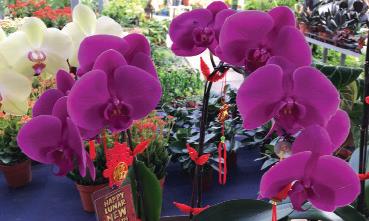
long-term bloom. You can always behold the other plants, which don’t promise a blossom, to savor the tropical Singapore atmosphere. To beautify and add a natural air purifier to your home, consider any one of these plants. Your local wet market is very likely to have a flower stall, where you can purchase many of these beauties. In Bedok, as well as along Thompson Road, garden centers carry a broader variety of plants.
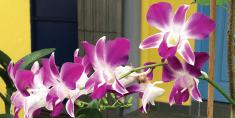
indirect light, with minimum watering (an ice cube once a week) and need air flowing around their root systems. As in nature, where these epiphytes grow high up in trees, moth orchids appreciate having their roots gently misted in an airy, breezy environment. Dendrobium orchids, according to Wilson Wong (greenculturesg.com) and Jon Van Stile (TheSpruce.com) are the “easy orchids.” Also known as “cane orchids,” they display a series of small blooms along a willowy stem, and can be kept in direct sun, especially on the roots. Dendrobium or cane orchid
Since moving from Philadelphia to Singapore, Helena has pursued her interest in art and writing. Her participation in the Urban Sketchers of SIngapore has brought her to many beautiful garden spots on the island.


